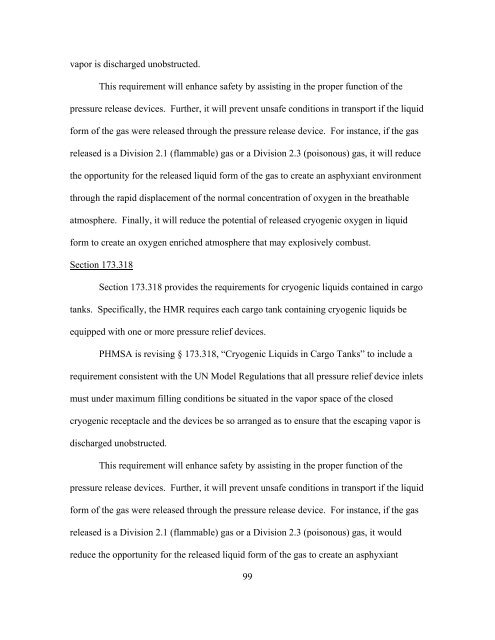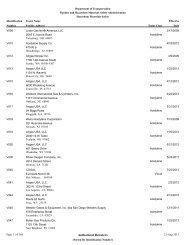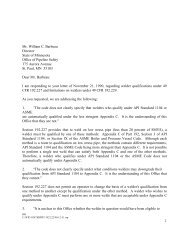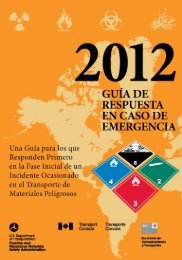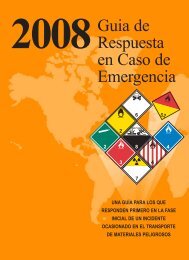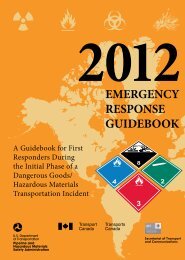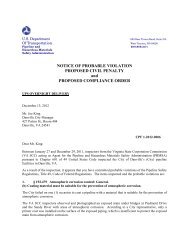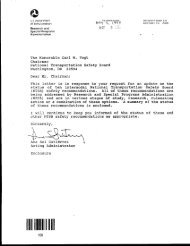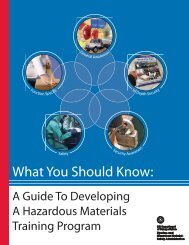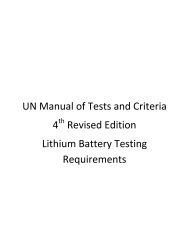- Page 1 and 2:
Billing Code: 4910-60-P DEPARTMENT
- Page 3 and 4:
E. Regulatory Flexibility Act, Exec
- Page 5 and 6:
Amendment 36-12 to the IMDG Code, a
- Page 7 and 8:
Nucon International Inc. (Nucon) P
- Page 9 and 10:
may not issue or enforce any regula
- Page 11 and 12:
Used Medical Devices The UN Model R
- Page 13 and 14:
proposed in the NPRM creates confli
- Page 15 and 16:
lithium batteries. This final rule
- Page 17 and 18:
Goods Code, 2010 Edition, Incorpora
- Page 19 and 20:
multi-modal applicability. PHMSA is
- Page 21 and 22:
to § 176.137, and small vessel com
- Page 23 and 24:
pound) to include transportation by
- Page 25 and 26:
3282 Organometallic compound, toxic
- Page 27 and 28:
identification number (UN3506) for
- Page 29 and 30:
The portable tank code assigned to
- Page 31 and 32:
crewmembers in carry-on baggage, ch
- Page 33 and 34:
UN3090 Lithium battery UN3091 Lithi
- Page 35 and 36:
2.4 m (8 feet) from the ship’s si
- Page 37 and 38:
Column (10A) in the HMT is revised
- Page 39 and 40:
lasting, Type B Explosive, blasting
- Page 41 and 42:
Cartridges, power device UN0381 Pro
- Page 43 and 44:
Hexanitrostilbene UN0392 43 water,
- Page 45 and 46:
provisions] specifies codes for sto
- Page 47 and 48: stowage code 25 is not currently li
- Page 49 and 50: The following proper shipping names
- Page 51 and 52: shipments. DOD recently asserted th
- Page 53 and 54: Special Provision 118 Special provi
- Page 55 and 56: Currently, neutron radiation detect
- Page 57 and 58: held by a capacitor, as calculated
- Page 59 and 60: aircraft batteries into Part 175 th
- Page 61 and 62: Special Provision A189 We are addin
- Page 63 and 64: equirements in Subpart R and Subpar
- Page 65 and 66: chemicals under pressure as well as
- Page 67 and 68: Section 172.203 This section detail
- Page 69 and 70: 2017. PHMSA maintains that there is
- Page 71 and 72: is adopting this change, consistent
- Page 73 and 74: changes to regulatory text language
- Page 75 and 76: FBCs must be transported in a conve
- Page 77 and 78: document regarding proposed modific
- Page 79 and 80: various packaging provisions. Secti
- Page 81 and 82: Group II to Packing Group III from
- Page 83 and 84: Section 173.159a provides exception
- Page 85 and 86: egarding the air transport of manuf
- Page 87 and 88: to the list of authorized packaging
- Page 89 and 90: Section 173.196 prescribes the pack
- Page 91 and 92: PHMSA is adding “Metal box other
- Page 93 and 94: vapor when transported by vessel. T
- Page 95 and 96: inhalation, Division 6.1, Packing G
- Page 97: may not be carried onboard an aircr
- Page 101 and 102: Part 175 Section 175.8 Section 175.
- Page 103 and 104: The term “Closed cargo transport
- Page 105 and 106: definition calls for and is maintai
- Page 107 and 108: (a)(9) concerning security devices
- Page 109 and 110: open flames.” Deleted stowage pro
- Page 111 and 112: exception for goods of division 1.4
- Page 113 and 114: Section 176.138 prescribes general
- Page 115 and 116: containers used to transport Class
- Page 117 and 118: ignition.” Section 176.400 Sectio
- Page 119 and 120: transportation of shipments UN2211
- Page 121 and 122: Section 178.512 Section 178.512 pre
- Page 123 and 124: Packagings, the criterion that a fi
- Page 125 and 126: adopted for Large Packagings in HM-
- Page 127 and 128: FBCs. A righting test is used to me
- Page 129 and 130: commerce are consistent with standa
- Page 131 and 132: would directly incur four different
- Page 133 and 134: We then multiplied this $498 billio
- Page 135 and 136: This final rule addresses covered s
- Page 137 and 138: in the annual burden and costs of b
- Page 139 and 140: statement on actions significantly
- Page 141 and 142: we would harmonize the HMR with int
- Page 143 and 144: PHMSA believes the amendments in th
- Page 145 and 146: comment, if submitted on behalf of
- Page 147 and 148: safety, Packaging and containers, R
- Page 149 and 150:
(3) ANSI N14.1 Uranium Hexafluoride
- Page 151 and 152:
(2) ASTM A 47-68 Malleable Iron Cas
- Page 153 and 154:
(21) ASTM A 607-98 Standard Specifi
- Page 155 and 156:
(42) ASTM D 3828-07a, Standard Test
- Page 157 and 158:
(4) AAR Standard 286; AAR Manual of
- Page 159 and 160:
(5) CGA Pamphlet C-6.2, Guidelines
- Page 161 and 162:
(1) USDOE, CAPE-1662, Revision 1, a
- Page 163 and 164:
London, SE1 7SR, United Kingdom or
- Page 165 and 166:
(17) ISO 4126-1:2004(E): Safety dev
- Page 167 and 168:
acetylene—Periodic inspection and
- Page 169 and 170:
(x) National Board of Boiler and Pr
- Page 171 and 172:
Virginia 22314. (1) TTMA RP No. 61-
- Page 173 and 174:
SE60DC; SE60DE AAR Catalog Nos. SE6
- Page 175 and 176:
Pantone Incorporated 590 Commerce B
- Page 177 and 178:
10B [Other provisions] specifies co
- Page 179 and 180:
under “[REMOVE]”, by adding the
- Page 181 and 182:
* * * * * * * Cartridges for weapon
- Page 183 and 184:
G Toxic by inhalation liquid, flamm
- Page 185 and 186:
[ADD] * * * * * * * Aerosols, corro
- Page 187 and 188:
* * * * * * * G Nitriles, liquid, t
- Page 189 and 190:
G Toxic by inhalation liquid, water
- Page 191 and 192:
substance * * * * * * * Ammonium pe
- Page 193 and 194:
G Articles, explosive, n.o.s. 1.4S
- Page 195 and 196:
* * * * * * * Benzyldimethylamine 8
- Page 197 and 198:
Calcium hypochlorite mixture, dry,
- Page 199 and 200:
Cases, combustible, empty, without
- Page 201 and 202:
* * * * * * * AW Copra 4.2 UN1363 I
- Page 203 and 204:
Dicyclohexylammonium nitrite 4.1 UN
- Page 205 and 206:
W Fish meal, stabilized or Fish scr
- Page 207 and 208:
Fuzes, detonating, with protective
- Page 209 and 210:
* * * * * * * Igniters 1.1G UN0121
- Page 211 and 212:
mixture of alcohol and water, by ma
- Page 213 and 214:
* * * * * * * Nitrotriazolone or NT
- Page 215 and 216:
Projectiles, inert with tracer 1.4S
- Page 217 and 218:
G I I Rockets, with inert head 1.2C
- Page 219 and 220:
Sounding devices, explosive 1.2D UN
- Page 221 and 222:
Trinitrochlorobenzene or Picryl chl
- Page 223 and 224:
Zirconium picramate, dry or wetted
- Page 225 and 226:
consisting of sealed packets and ar
- Page 227 and 228:
engine, an internal combustion engi
- Page 229 and 230:
detectors, where the neutron radiat
- Page 231 and 232:
5.2 (organic peroxides); Division 6
- Page 233 and 234:
* * * * * A191 Notwithstanding the
- Page 235 and 236:
* * * * * TP39 The portable tank in
- Page 237 and 238:
capacity of 60 liters (16 gallons)
- Page 239 and 240:
Engines, internal combustion. Fish
- Page 241 and 242:
equirements of its specification an
- Page 243 and 244:
* * * * * (b) * * * (6) Division 1.
- Page 245 and 246:
* * * * * Cartridges, blank. Articl
- Page 247 and 248:
1. For UN Nos. 0004, 0076, 0078, 01
- Page 249 and 250:
of substance must be packed in an i
- Page 251 and 252:
inner packagings must have taped sc
- Page 253 and 254:
include nitro-derivatives such as t
- Page 255 and 256:
132(a) Not necessary Not necessary
- Page 257 and 258:
136 Bags Not necessary 1H2). Boxes.
- Page 259 and 260:
140 Bags Not necessary fiber (1G).
- Page 261 and 262:
used in lieu of combination packagi
- Page 263 and 264:
such articles may be marked with th
- Page 265 and 266:
§ 173.158 Nitric Acid * * * * * (d
- Page 267 and 268:
(1) In combination packagings inten
- Page 269 and 270:
(b) When transported as cargo, manu
- Page 271 and 272:
material may not exceed 10 kg (22 l
- Page 273 and 274:
material. The total quantity of pol
- Page 275 and 276:
may build up in use, through a vent
- Page 277 and 278:
with strong, tight inner metal cans
- Page 279 and 280:
than 15 kg (33 pounds) each. * * *
- Page 281 and 282:
§ 173.194 Gas identification sets.
- Page 283 and 284:
steel or aluminum: 4N” is added b
- Page 285 and 286:
accordance with the requirements of
- Page 287 and 288:
* * * * * (c) For transportation by
- Page 289 and 290:
Di-(3, 5, 5-trimethylhexanoyl) pero
- Page 291 and 292:
(ii) By equipping the UN pressure r
- Page 293 and 294:
d. In the table, the value listed f
- Page 295 and 296:
§ 173.316 Cryogenic liquids in cyl
- Page 297 and 298:
(2) In UN 1A2, 1B2, 1N2 or 1H2 drum
- Page 299 and 300:
(iii) Visual inspection including r
- Page 301 and 302:
§ 173.175. (21) An internal combus
- Page 303 and 304:
goods are stowed on sparred grating
- Page 305 and 306:
(e) Notwithstanding the stowage pro
- Page 307 and 308:
provisions 25 and 128 are revised a
- Page 309 and 310:
(3) Except where the consignment of
- Page 311 and 312:
to read as follows: § 176.146 Segr
- Page 313 and 314:
91. In § 176.400, paragraphs (a) a
- Page 315 and 316:
(1) The cargo transport unit has be
- Page 317 and 318:
follows: * * * * * as follows: 98.
- Page 319 and 320:
* * * * * 101. In § 178.980, parag
- Page 321 and 322:
(iii) The capital letter Z identify
- Page 323 and 324:
permitted for a period of time not
- Page 325 and 326:
emain the same; (d) Design qualific
- Page 327 and 328:
(5) Manufacturer of the packaging;
- Page 329 and 330:
§ 178.1050 Top lift test. (a) Gene
- Page 331 and 332:
or after removal of the test load.
- Page 333:
§ 178.1070(c)(1), must be subjecte


